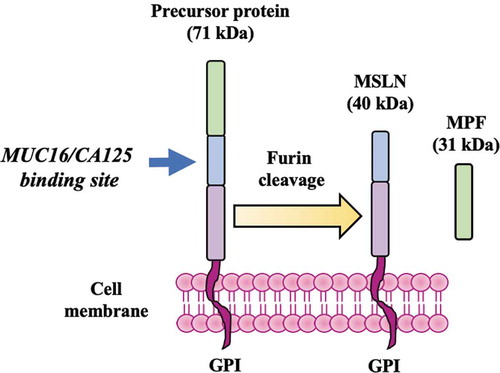Figures & data
Figure 1. MSLN and MPF. A precursor protein of ~71 kDa is divided via furan cleavage into a ~ 40 kDa GPI-anchored, membrane-bound protein which contains a MUC16/CA125 binding site known as mesothelin (MSLN), and a soluble protein of ~31 kDa known as megakaryocyte-potentiating factor (MPF). MSLN expression is normally restricted on the surface of mesothelial cells but it is also overexpressed in a broad range of cancers

Figure 2. The CAR generations. The first-generation CARs consisted of an extracellular scFv region (VL connected to VH via a linker) responsible for the recognition of the target tumor antigen, connected via a spacer or hinge to a transmembrane domain (both spacer/hinge and transmembrane domain usually CD8?-derived), which finally led to an intracellular CD3? domain responsible for CAR-T cell activation (signal 1). Along with CD3?, an intracellular co-stimulatory domain (CD28 or 4–1BB; signal 2) was added to generate the 2nd generation CAR-T cells and a second co-stimulatory domain (CD28, 4–1BB, OX40, DAP10 or TLR2) was included to generate the 3rd generation CAR-T cells. 4th generation CAR-T cells consist of CD3? along with co-stimulatory domain 1 but are also engineered to express and secrete an inflammatory cytokine such as IL-12 (but they can also secrete an inflammatory chemokine or an antibody targeting immune checkpoint inhibitors) which can modify the tumor microenvironment. Finally, 2nd generation CARs may contain, apart from the intracellular CD3? (signal 1) and co-stimulatory domain 1 (signal 2), an IL-1 R? domain which mediates JAK-STAT signaling (signal 3), providing the third signal for full T cell activation

Table 1. Phase I/II clinical trials of MSLN-targeted CAR T cells
